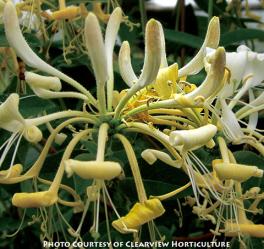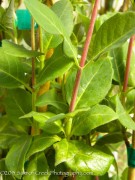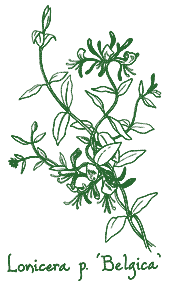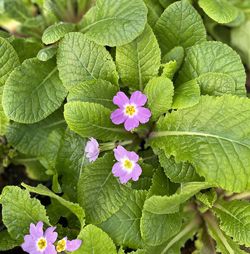Lonicera
Honeysuckle
Entrancing hummingbirds and butterflies, our superb no-fuss selections are hardy, undemanding and appreciative of adequately moist fertile soil. Medium Band.

Aptly named and well-worth the wait, this compact highly perfumed cross is the prized outcome of a 10 year breeding program by the Netherlands’ Boskoop Horticultural Research Center. Climbing branches with somewhat rounded, shiny dark green foliage comprise the easily managed bushy growth that boasts a bevy of purplish red buds and clustered tubular blooms, first opening a creamy yellow then darkening to a lovely orange yellow. An award winning cross between Lonicera japonica ‘Halliana’ and Lonicera periclymenum ‘Belgica Select’, ‘Honey Baby’s dwarf evergreen habit can garnish a container, an outdoor living space or a smaller garden, while its delectable smelling flowers unfurl from summer ’til fall. Medium Band.
Blooms July–October
Size: 4' 0" – 6' 0" high x 0" & spreading wide.
Hardy to zone 4.
Lonicera periclymenum ‘Belgica’ (T-0268)
Each $17.75


Heralding summer, this energetic sweetly scented twiner blooms earlier than most Honeysuckles and is set apart by tubular flowers, whose interiors change color as they mature amid oval semideciduous green leaves. Sprightly deep pink clusters of long slender curling buds open into large crimson bugles with creamy-white centers, which later showcase bright yellow and red shades. Especially fragrant at the end of the day, ‘Belgica’ can be pruned to develop a shrubby bearing or be encouraged to ramble up walls, trellises, pillars, the branches of large shrubs or a Cercidiphyllum. Medium Band.
Blooms May–August
Size: 6' 0" – 8' 0" high x 0" & spreading wide.
Hardy to zone 5.


Samuel Pepys called it the trumpet flower and wrote, “The bugles blow scent instead of sound.” ‘Serotina’ bears multitudes of spidery-looking, fuchsia-colored buds, which open into pink, sweet-smelling bugles that later fade to a creamy salmon color. You can prune this vigorous semideciduous vine to make it more shrublike or let its bluish green foliage climb into the branches of a Cercidiphyllum.
Blooms June–September
Size: 6' 0" – 8' 0" high x 4' 0" wide.
Hardy to zone 6.
Introduced to the western world in 1900 by esteemed plant explorer E. H. Wilson, this magnificent deciduous Honeysuckle is unique for its shade-loving constitution and sensational, 3 in. long bright golden yellow trumpets. Though the large terminal clusters are not fragrant, each hosts 10 to 20 flashy flowers amid red-flushed buds and appealing good-sized blue-green leaves that burnish purple. Chinese Honeysuckle’s young robust stems can be trimmed immediately after blooming to promote a tidy, easily managed low maintenance framework plus flowers galore.
Blooms June–August
Size: 12' 0" – 20' 0" high x 0" – 55-1/2' wide.
Hardy to zone 6.











